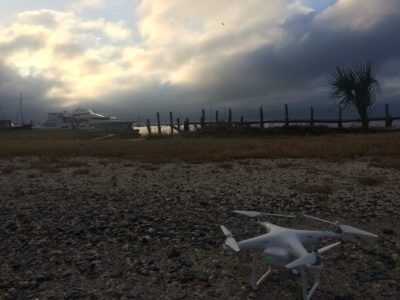From February to late April 1997, the  Texas Historical Commission (THC), under the Direction of Dr. James Bruseth, carefully documented and disassembled the remains of the barque-longue Belle. The fourth vessel added to the colonizing fleet of René-Robert Cavelier, Sieur de La Salle, Belle, sank in the Texas coastal waters of Matagorda Bay, in the winter of 1687. The loss of the vessel deprived the La Salle and the French settlers under his command, an opportunity of water-borne escape or resupply, and the colony failed within a few short months.
Texas Historical Commission (THC), under the Direction of Dr. James Bruseth, carefully documented and disassembled the remains of the barque-longue Belle. The fourth vessel added to the colonizing fleet of René-Robert Cavelier, Sieur de La Salle, Belle, sank in the Texas coastal waters of Matagorda Bay, in the winter of 1687. The loss of the vessel deprived the La Salle and the French settlers under his command, an opportunity of water-borne escape or resupply, and the colony failed within a few short months.
Although the location of wreck site was discovered in 1995, it was not until large pumps had drained the Matagorda Bay waters from a double-walled cofferdam in September of 1996 that the THC archaeologists could fathom the scope and breadth of the discovery. All totaled, over the next eight months, more than a million artifacts of varying sizes, shapes, and composition emerged from the bog at the bottom of the cofferdam. The largest artifact, comprising approximately 35% its original volume was the remains of Belle. All of the finds, discovered after September 1996, were shipped to the Conservation Research Laboratory (CRL) at Texas A&M University. The similar missions, but varying expertise of the two state agencies, formed an extraordinary partnership that bolstered the stabilization of both the “colonial-kit” of small material cultural finds, and the vessel herself.
During the course of the four month disassembly, twice weekly, a shipment of timbers made the 200 mile trip from Matagorda Bay to the CRL. By the date that the final timbers were delivered in early May, 384 principal timbers weighing in excess of 23,000 pounds were in the lab’s storage vats awaiting stabilization. CRL Director, Dr Donny L. Hamilton tasked his staff to develop a plan to stabilize the timber in toto instead of individually. His concern was that the multi-degraded state of the waterlogged timber would inhibit alignment of plank to frames in a post stabilization reconstruction. Since the final goal for the artifact was a elaborate museum display, an equally difficult challenge was to overcome the physics that impact the display of any watercraft structure, at sea level – air is 784 times less dense than water, the medium for which the structure was designed, and those forces can generate considerable stress and strain on already degraded elements. Modern museum practice seldom employs rows of artifact cases with rigidly ordered object dichotomies, and few museums abide by the classical notions of kunstkammer, or “cabinet of curiosities”. The modern museum endeavors to educate and inspire its audience toward further discovery, all the while competing with alternative suppliers of entertainment for a limited amount of leisure revenue (Casey: 80). Cast against the backdrop of this theory, the display of Belle, or any archaeological ship remains represent somewhat of a paradox: a large, static, often seemingly lifeless object, but one possessing a certain vitality and characteristics and project of a sense-of-place that can easily pique visitor curiosity.
To bring hundreds of friable, fragmented, and waterlogged pieces into a well supported meaningful unit, pre-stabilization, while balancing representation of the artifact’s significance required an elaborate decision making process that could have only been achieved by drawing on aspects of “whole systems engineering”. It was this “whole thinking” approach that lead to the creation of an endoskeleton of individually cast, carbon fiber laminates, the ability to modify that support structure to allow the hull to again be laid at 69 degrees, and ultimately a methodology to freeze-dry the timbers. The initial timber and structural stabilization plan called for a “two-step” procedure to imbibe low and high molecular weights of Polyethylene glycol (PEG) into the timber before a controlled dehydration (Hoffman:1986). Reconstruction of the timbers commenced in 2000 and the reconstruction and laminate casting had been completed by 2004. In 2008, with the cost of PEG skyrocketing (a hydrocarbon based product its production cost mirrors fluctuations in crude oil prices) and having only completed 70% of the first aqueous bath with the low molecular weight PEG, our partners at the THC asked if there was a procedure that could be instituted to reduce costs. Four alternative methods were proposed and subjected to peer review. The unanimous consensus was to follow a protocol of freeze-drying the individual timbers in a chamber large enough that no individual element had to be intentionally broken or cut. That way, less low molecular weight PEG would be needed, and once disassembled again, the timbers could be consolidated in vats that would reduce the quantity of required high molecular weight PEG by 85%.
Having first been considered a viable stabilization method for wet organic archaeological materials in the mid to late 1960s, freeze-drying is not a new stabilization procedure (Ambrose: 1971). Yet, application of the methodology has to date been generally limited to small or medium sized items, not large integrated structures with complex curves. Several smaller craft have been successfully freeze-dried. The reconstruction of a Sixteenth-Century Basque Chalupa (1998), freeze-dried by Parks Canada (Moore: 1998) and the Bronze-Age Dover Boat freeze dried by the Mary Rose Trust in Portsmouth, UK have both yielded satisfactory results. The difficulty in freeze-drying larger ship timbers are the twists and compound curves of the hull and ceiling planks. When both free and bound water is driven off, or desorbed, during the lyophilization process the physical properties of the wood shifts along the ductility scale from malleable to brittle. In other words, the shape that the plank holds entering the process will be its final shape upon completion. Timbers not placed on molds that accurately mimic the curves and twists of the hull shape may never again fit the hull shape. If placed in the freeze-dryer flat any attempt to recreate, or force the curve after the process would most likely result in cracking or splitting of the timber. Fortunately, three-dimensional recording technologies have made considerable advances in the last decade and following a reconstruction of Belle in the Lab’s 60’ x 20’ x 12’ vat it was digitally recorded in order to delineate the lines and loft molds that hold to the proper shape of the hull curvature.
On molds in the 40’ long and 8’ diameter product chamber the timbers, imbibed water and PEG are rapidly frozen to temperatures that exceed minus 40o C. Thermal couples placed on the surface and situated in the interior of the timber, monitor the temperature and sublimation of the ice. Once completely frozen, a vacuum is applied to the product chamber and reduced to pressures as low as 150 millitorr. The low temperature and pressure allow the ice in the wood to sublimate, or shift from a solid to a vapor, skipping the liquid phase. Once all the timbers have completed the freeze-drying process the hull will be reconstructed once again, this time in the public-eye on the main floor of the Bob Bullock Texas State History Museum in Austin, TX. Scheduled starting date is November 2013.
Read the rest of the Tech Week posts, all about public archaeology and underwater archaeology!
References
- Ambrose, W.
- 1971 “Freeze-drying of swamp degraded wood” in Conservation of Wooden Objects: New York Conference on Conservation of Stone and Wooden Objects, preprints of the contributions, 7-13 June, 1970. New. York: The International Institute for the Conservation of Historic and Artistic Works, 53-58.
- Casey, Valarie.
- 2005 “Staging Meaning; Performance in the Modern Museum”. TDR 49 (3) 2005: 78-95.
- Clark, P.
- 2004 The Dover Bronze Age boat in context: society and water transport in prehistoric Europe. Oxford, UK: Oxbow.
- Hoffman, Per.
- 1986 “On the Stabilization of Waterlogged Oakwood with PEG. II Designing a Two-Step Treatment for Multi-Quality Timbers,” Studies in Conservation Vol. 31. N3 Aug: 103-113.
- Moore, C.
- 1998 “Reassembly of a Sixteenth-Century Basque Chalupa” Material History Review 48 (Fall 1998) 38-44.





